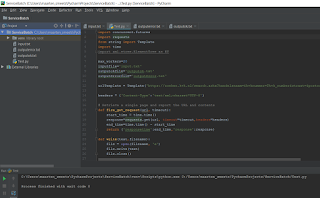Scripts such as this might help bridging part of the gap between the old fashioned batch oriented world and the service world. You can for example use it to call services based on a text-file export from an old system to create certain entities in a modern system which offers APIs. Scripts such as these should of course not be used to actually perform structured regular integration but are valuable as one-off solutions. The provided scripts of course come with no warranties or guarantees of any nature. Most likely you will need to make them suitable for your specific use-case.
Python setup
The scripts below require Python 3.6 with the requests module installed (pip install requests). The other used modules are present by default in your usual Python installations. I've used PyCharm by JetBrains as IDE. Without IDE, you can also install Python 3.6 from python.org here to just run the script.
Performing calls to SOAP services
SOAP services use the same endpoint for all requests. Based on the operation (the SOAPAction HTTP header), a different part of the service is executed. The message contents can differ. For example, you want to call a service for a list of different customers. A template message is ideally suited for such a case. The below Python 3.6 script will do just that. Generate messages based on a template and an input file and fire them at a service endpoint with a specified number of concurrent threads. After the response is received, it is parsed and a specific field from the response is saved in an output file. Errors are saved in a separate file.
You can view the script here. The script is slightly more than 50 lines and contains Python samples of (among other things):
- How to execute SOAP calls (POST request with HTTP headers) with the requests module
- How to work with a message template and variables with string.Template
- How to concurrently execute calls with concurrent.futures
- How to parse SOAP responses with xml.etree.ElementTree
The line Maarten in input.txt will give you Maarten : Hello Maarten in the outputok.txt file if the call succeeded. I've used a simple SOA Suite test service which you can also find in the mentioned directory.
Performing calls to REST services
When working with REST services, usually the URL contains variables. In this example I'm calling an online and publicly available API at the Dutch Chamber of Commerce to search for companies based on their file number (KvK number). When I receive the result, I'll look if it is found and only has a single location. In other cases, I'll consider it an error.
You can view the script here. It contains samples of (among other things) on how you can do URL manipulation and GET requests. The parsing of the response for this sample is extremely simple. I just check if the result document contains specific text strings. For a 'real' REST service you might want to do some more thorough JSON parsing. For this example, I've kept the code as simple/short as possible.


No comments:
Post a Comment